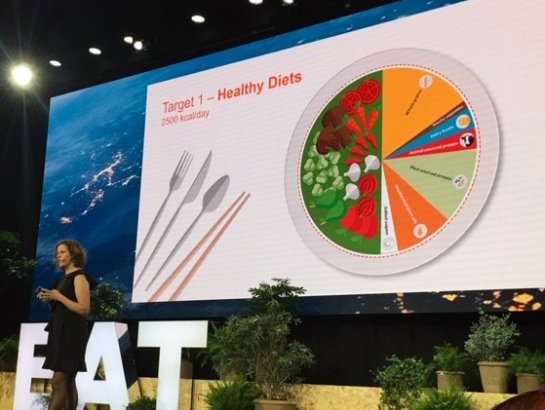Peter Goldstein
The speakers at this year’s EAT Stockholm Food Forum delivered a consistent message to the roughly 1,000 attendees: Current global diets are damaging human health and planetary well-being. The foods we produce, and the ways we produce them, contribute to alarming trends in the global climate, pollution, and biodiversity loss. We need to take remedial actions locally and globally—urgently.
The
“Food won’t fix anything until we come together to fix food,” declared Dr. Gunhild Stordalen, founder and executive chair of the Norway-based EAT Foundation, which organizes the annual Forum. She hit a hopeful note amid the cataclysmic warnings, observing that in 2019, “the world is starting to grasp that the food transformation is just as critical as the energy transformation” to avoid disaster.
A lot of people I spoke with at the Forum asked about how biofortification fits into this picture. How can naturally nutritious staple crops—the types advanced worldwide by HarvestPlus and hundreds of partners that currently benefit almost 40 million people across several low- and middle-income countries (LMICs)—contribute to a sustainable, healthy food future for all?
The connection may not be immediately obvious to some observers who consider rice, wheat, maize, beans, and other common staple crops symbols of a historic focus on addressing hunger by filling stomachs with scant regard to nutritional value. Why should we encourage people to eat these staples when they really need to
To be sure, HarvestPlus is a strong proponent of dietary diversity as the most effective way to ensure people can thrive physically and mentally. Unfortunately, billions of people around the world, particularly in LMICs, are unable to afford or readily access healthy, diverse diets. These people remain dependent on relatively cheap, familiar staple foods for a large proportion of their calorie intake, which leaves them vulnerable to blindness, stunted development, diarrheal and respiratory infections—even death. More than two billion people are currently experiencing micronutrient
Biofortification is based on the principle that resource-poor people dependent on staple food crops will continue to eat the same quantity of staples and swap in more-nutritious varieties. In other words, biofortification-inclusive nutrition strategies do not seek to encourage people to eat more staples to receive the desired boost in micronutrient intake. It is a substitution of more-nutritious staple food crops. As such, this approach complements other interventions like supplementation and fortification, by improving the nutrient value of the foods these families depend on.
Biofortification benefits those most vulnerable to deficiencies in micronutrients such as vitamin A, zinc or iron, especially children and women of childbearing age. Most biofortified varieties will eventually provide from 50 percent to 80 percent of a woman’s or child’s daily needs, depending on the nutrient and amount of food consumed. Vitamin A orange sweet potato can provide 100 percent of daily vitamin A needs.
The harsh reality is that micronutrient deficiency is likely to persist as a widespread problem for a long time—particularly for the world’s smallholder farming families in LMICs who have very limited resources at their disposal. A recent study, published in Nature Sustainability, looked at various scenarios for economic and climate trends around the world through 2050 and used these to project future nutrition outcomes. The results of the study showed that even under the most optimistic economic scenario and disregarding the impact of climate change, micronutrient deficiencies are projected to remain widespread in many areas of the world through at least
The EAT Forum also highlighted the need to develop and provide crops that can withstand the impact of warming trends on water availability and other factors influencing cultivation. In fact, biofortified crops are developed from varieties bred for resistance to climate change effects such as tolerance to heat, diseases, and drought. For example, iron-biofortified beans are also heat and drought tolerant; iron pearl millet is heat tolerant and bred to thrive on low levels of water. Biofortified varieties are also tested under various stress conditions to make sure their nutritional benefits will hold under adverse climates.
Recent studies show climate change will also exacerbate micronutrient malnutrition. First, under rising CO₂ levels, plants will likely lose nutritional value. The additional 175 million people who may subsequently become zinc deficient, are at greater risk of diarrheal disease and respiratory infections; The 1.4 billion women of childbearing age and children under five who could lose more than four percent of their dietary iron are at risk of impaired mental development and learning capacity as well as increased weakness and fatigue. Second, climate change is projected to lead to higher food prices by creating more-volatile production outcomes, making it even harder for the poor to afford
Encouragingly, the attendees at the EAT Forum recognized the importance of investing in and promoting crops that are nutritious and climate resilient. Howard Frumkin, who heads the Our Planet, Our Health Programme at the Wellcome Trust, closed out the Forum with a virtual poll of attendees’ priorities for future action. As the image shows, identifying and developing nutritious, climate resilient crops scored particularly high. The EAT Forum crowd understood that solutions begin at seed level.
Equally important, Forum attendees recognized that any lasting solutions to create a better food future will be based on the role of farmers who need to buy
HarvestPlus agrees that engaging farmers worldwide to grow biofortified crops is an effective way of ensuring their participation in food systems solutions. The farmers will be producing the crops that not only improve nutrition but also help adapt to a changing world environment. – Harvest Plus




